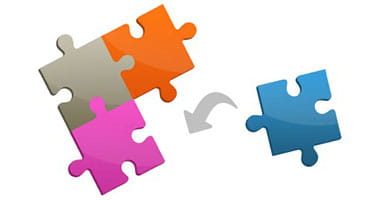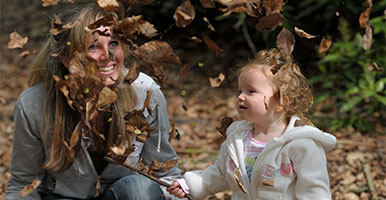Encouraging a physically active lifestyle

Being physically active every day is vital for the healthy growth and development of babies (<1y), toddlers (1-2y) and pre-schoolers (3-4y) and physical activity is an important component in addressing unhealthy weight.
Practitioners working with young children and their families are in a good position to educate and support parents/carers to promote an active family lifestyle.
This section aims to provide ideas for physical activities to help parents/carers encourage babies and young children’s healthy growth and physical development, and to support them to develop the skills, strength, and confidence to enable them to be more active.
Physical activity ideas for babies
Parents should encourage babies to be active throughout the day, every day, in a variety of ways. Play – including physically active play – should be a key component of the child’s schedule alongside sleeping and feeding. The child’s favourite playmate is their parent/carer, so it is important that parents try to spend time playing with their child each day.
Encouraging movement and tummy time helps babies to develop neck and head control, and to develop strength and control in their arms and legs.
- When babies are very small, they enjoy just wriggling around on the floor.
- By six months, babies may be able to reach and grasp objects, push and pull, sit unaided and roll from their tummy to their back.
- By 12 months, babies are more mobile and may be able to crawl, stand, cruise holding onto furniture or even start walking.
Each child will develop at their own rate and so activities can be adapted and tailored in accordance with their stage of development.
Tummy timeTummy time is very important to help strengthen neck, back and shoulder muscles that the child needs for sitting and crawling. Tummy time can be started from birth by lying the baby on the parent’s chest or lap for a minute or two at a time (NB this should only be done when the parent is wide awake and unlikely to fall asleep). Parents can gradually increase the amount of tummy time as the baby becomes more used to it and progress to the floor once the baby is ready. It’s quite common for babies to dislike tummy time initially so encourage parents to try different strategies such as:
Babies should not sleep on their tummies. |
Click on the tabs below for more age-specific physical activity ideas for babies.
Faq Items
Babies aged 0-6 months
Babies aged 6-12 months
Physical activity ideas for toddlers and pre-schoolers
One of the easiest ways to help a family increase their toddler or pre-schooler’s physical activity is to help them build physical activity into their daily lives and make it a fun and enjoyable activity for the whole family. This makes reaching the recommended guidelines easier as parents do not have to find additional time in their day to ensure their child is being sufficiently active.
This active games handout can be given to parents/carers to support the conversations you have with them.
Click on the tabs below for ideas when families are out and about, at home or in the garden.
Faq Items
Getting around
At home
In the garden
Outside
Local activities
Physical activity for young children with a disability
All babies and young children need to be active, including children with a long-term condition or disability, unless their medical professionals have advised that physical activity should be restricted.
Just like other children, they will enjoy being active and it will help with their development.
Many of the physical activity ideas provided here could be adapted to suit individual children’s capabilities.
Increasing physical activity for the whole family
It is important for the whole family to be physically active, both for the family’s and child’s health. Parents and carers can encourage their child to be active by getting involved and spending time actively playing with them, and by giving children praise and encouragement.
Even if a family member is unable to be physically active themselves, it is important they are positive about physical activity and actively encourage the child to participate. Adults are important role models and their involvement in physical activity and active play will encourage their young child to be more active, and enjoy being active. This will stimulate further participation in physical activity.
Increasing children’s confidence to be physically active
Some young children can be shy and reluctant to join in with others. It is important these children are guided and shown how to enjoy active play (e.g., how to use different equipment and play spaces).
Parents/carers can also be anxious about the risks that physical activity might bring (e.g., falling). It is important to help parents/carers understand the benefits of children being active and encourage them to talk positively about physical activity with their children (and try not to show children when they are feeling nervous themselves). This will help increase children’s confidence.
Parents/carers can do this by supporting the child’s autonomy, competence and relatedness (to recap on these concepts refer to the communicating with parents about child weight module).
Here are a few tips on how parents/carers can communicate positively about physical activity:
- Offer specific praise and encouragement to children while they are being active e.g., praising tummy time endeavours, catching skills, encouraging a child to walk rather than be in a pushchair (relatedness and competence)
- Encourage children to explore (parents/carers may need to be willing to step back and allow some risks – within a safe environment) (autonomy)
- Encourage children to do things for themselves (even if it does take longer) rather than be tempted to do it for them (competence and autonomy)
Reducing screen time
It is important to limit the amount of time young children spend in front of screens (including TV, games consoles, tablets, mobile phones). If a young child does spend time in front of a screen, it is important that it is educational, or encourages them to be physically active. Through working with parents of young children, you can help to educate parents in the importance of reducing screen time and how they can go about achieving this.
Here are a few ideas to help parents/carers reduce their child’s screen time:
- Replace the TV as a ‘babysitter’
Parenting a young child can be tiring, and it can be tempting for parents/carers to sit infants and toddlers in front of the TV to make time for household chores (or simply for parents/carers to have a rest). If this is something parents/carers struggle with, a good first step is to show you empathise with their needs and acknowledge this is a normal feeling for parents/carers to have. Encourage them to limit the frequency and duration of the “TV babysitter” whenever possible, and to try and come up with other activities that can keep the child safe and distracted for 5-10 minutes. For example, stacking toys, or playing with building blocks. - After nursery action plan
Children may turn to screens (e.g., TV, tablets) when they have few other activities to do. Try to support parents/carers to come up with after work and after school/nursery activities that children can do instead of screens. They could make this a fun task and give their child some autonomy by involving them in choosing activities (which then becomes an activity in itself!). For example: - make a “top 10 activities” list together
- create a “lucky dip” of activities together that the child can later select from
- make a “spinning wheel” with different activities to choose from.
Create a viewing calendar
Parents/carers could ask their children to choose their favourite programmes and they can be put on a viewing calendar. The TV can then be put on for these programmes, and then turned off afterwards (while children are watching TV, parents/carers can set a timer and continue undisturbed with their own activities).
In accordance with the World Health Organisation guidelines, try to support parents to set a maximum duration of 1 hour for these programmes each day. The risk with TV viewing is that once the TV is turned on children continue to watch whatever programmes come next.
Further resources
- Infographic showing UK Chief Medical Officers’ (2019) physical activity guidelines for early years. This can be useful to print off and use as a prompt when discussing physical activity with parents/carers.
- Active games for young children handout, which can be given to parents/carers of toddlers and pre-schoolers to take away.
- This BMJ blog written during the Covid pandemic contains some relevant ideas for encouraging under 5s to be active at home.
- For a more comprehensive guide to practical ideas for physically active play in under 5s, please see the British Heart Foundation’s Early Movers guide.



